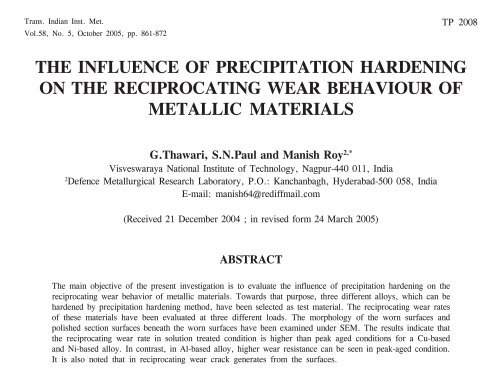Vol.58, No. 5 - Indira Gandhi Centre for Atomic Research
Vol.58, No. 5 - Indira Gandhi Centre for Atomic Research
Vol.58, No. 5 - Indira Gandhi Centre for Atomic Research
You also want an ePaper? Increase the reach of your titles
YUMPU automatically turns print PDFs into web optimized ePapers that Google loves.
Trans. Indian Inst. Met.<br />
<strong>Vol.58</strong>, <strong>No</strong>. 5, October 2005, pp. 861-872<br />
TP 2008<br />
THE INFLUENCE OF PRECIPITATION HARDENING<br />
ON THE RECIPROCATING WEAR BEHAVIOUR OF<br />
METALLIC MATERIALS<br />
G.Thawari, S.N.Paul and Manish Roy 2,*<br />
Visveswaraya National Institute of Technology, Nagpur-440 011, India<br />
2<br />
Defence Metallurgical <strong>Research</strong> Laboratory, P.O.: Kanchanbagh, Hyderabad-500 058, India<br />
E-mail: manish64@rediffmail.com<br />
(Received 21 December 2004 ; in revised <strong>for</strong>m 24 March 2005)<br />
ABSTRACT<br />
The main objective of the present investigation is to evaluate the influence of precipitation hardening on the<br />
reciprocating wear behavior of metallic materials. Towards that purpose, three different alloys, which can be<br />
hardened by precipitation hardening method, have been selected as test material. The reciprocating wear rates<br />
of these materials have been evaluated at three different loads. The morphology of the worn surfaces and<br />
polished section surfaces beneath the worn surfaces have been examined under SEM. The results indicate that<br />
the reciprocating wear rate in solution treated condition is higher than peak aged conditions <strong>for</strong> a Cu-based<br />
and Ni-based alloy. In contrast, in Al-based alloy, higher wear resistance can be seen in peak-aged condition.<br />
It is also noted that in reciprocating wear crack generates from the surfaces.
















